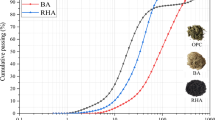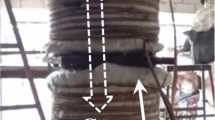Abstract
The LCPC method is one of the most common abrasion tests used for determining soil and rock abrasivity. LCPC abrasivity coefficient (LAC) and LCPC brittleness coefficient (LBC) are two parameters obtained from this method. The rotation speed (RS) and rotation time (RT) are two factors that affect the results of this experiment. In this paper, the effect of these two factors on quartz and feldspar minerals is investigated innovatively. The tests were carried out in two groups. In the first group tests, the RS was changed from 500 to 4500 rpm, and LAC and LBC were measured at RTs of 1, 2, 3, 4, and 5 min. The results showed that LAC and LBC increase nonlinearly with increasing RS and RT, and the relationship of LAC and LBC with RS and RT is affected by the mineralogy. Experimental relationships between LAC and RT with a coefficient of determination greater than 0.97 were proposed for quartz and feldspar. Study of two-dimensional images of grains showed that the impact of coarse grains on the wear of the impeller is more than that of fine grains. In the second series, the sample inside the container is replaced with a new sample each minute at different RS values. The results showed that by increasing RT, the LAC rate increased as well. Besides, the LAC increased linearly with increasing RT due to the effect of the grain size and shape changes, which were removed during the test. In addition, the effect of the RS on the LAC is greater than that of the RT. Comparing the result of these two series, the optimum rotation time (ORT) is defined as the time when the trend line in the LAC-RT graph changes from linear to logarithmic. This parameter indicates the moment at which the effect of grain shape and size on impeller wear starts to decline. The changes in ORT versus RS for quartz and feldspar are similar and exponential.
















Similar content being viewed by others
Abbreviations
- LCPC:
-
Laboratoire Central des Ponts et Chausées
- LAC :
-
LCPC abrasivity coefficient
- LBC :
-
LCPC brittleness coefficient
- RS :
-
Rotation speed
- RT :
-
Rotation time
- ORT:
-
Optimum rotation time
- UCS:
-
Uniaxial compression test
- BTS:
-
Brazilian tensile strength
References
Abu Bakar MZ, Majeed Y, Rostami J (2016) Effects of rock water content on CERCHAR abrasivity index. Wear 368:132–145. https://doi.org/10.1016/j.wear.2016.09.007
Abu Bakar MA, Majeed Y, Rostami J (2018) Influence of moisture content on the LCPC test results and its implications on tool wear in mechanized tunneling. Tunn Underg Space Technol 81:165–175. https://doi.org/10.1016/j.tust.2018.07.021
Abu Bakar MA, Iqbal MM, Majeed Y, Zahoor MK, Fowell RJ (2014) Reduced propeller speed effects on LCPC rock abrasivity test. Pakistan J Sci 66(1)
Abu Bakar MA, Zafar Z, Majeed Y (2020a) Abrasiveness evaluation of selected river gravels of Pakistan using LCPC rock abrasivity test. Bull Eng Geol Environ 1–17. https://doi.org/10.1007/s10064-019-01719-4.
Abu Bakar MA, Majeed Y, Rashid MA (2020b) Influence of propeller material hardness, testing time, rock properties, and conditioning on LCPC rock abrasiveness test. Bull Eng Geol Environ 1–18
AFNOR (1990) Granulats—Essai d’abrasivite’et de broyabilité. Association Francaise de Normalisation, Paris (NF P 18–579)
Al-Ameen SI, Waller MD (1994) The influence of rock strength and abrasive mineral content on the Cerchar Abrasive Index. Eng Geol 36(3–4):293–301. https://doi.org/10.1016/0013-7952(94)90010-8
Alavi Gharahbagh EA, Qiu T, Rostami J (2013) Evaluation of granular soil abrasivity for wear on cutting tools in excavation and tunneling equipment. J Geotech Geoenviron Eng 139(10):1718–1726. https://doi.org/10.1061/(ASCE)GT.1943-5606.0000897
Aligholi S, Lashkaripour GR, Ghafoori MT, Ghazali S (2017) Evaluating the relationships between NTNU/SINTEF drillability indices with index properties and petrographic data of hard igneous rocks. Rock Mech Rock Eng 50(11):2929–2953. https://doi.org/10.1007/s00603-017-1289-9
Barzegari G, Uromeihy A, Zhao J (2015) Parametric study of soil abrasivity for predicting wear issue in TBM tunneling projects. Tunn Undergr Space Technol 48:43–57. https://doi.org/10.1016/j.tust.2014.10.010
Barzegari G Uromeihy A Zhao J (2013) A newly developed soil abrasion testing method for tunnelling using shield machines. Q J Eng Geo Hydrogeol 46(1), (2013) 63–74. https://doi.org/10.1144/qjegh2012-039
Bjarnason G, Petursson P, Erlingsson S (2002) Quality assessment of aggregates for road construction, fragmentation, weathering, and abrasion. Public Roads Administration, Reykjavik, Iceland
Bruland A (1998) Hard rock tunnel boring: drillability test methods, Project report 13A-98, NTNU Trondheim, 21
Büchi E, Mathier JF, Wyss C (1995) Rock abrasivity—a significant cost factor for mechanical tunneling in loose and hard rock. Tunnel 5:38–44
Capik M, Yilmaz AO (2017) Correlation between Cerchar abrasivity index, rock properties, and drill bit lifetime. Arab J Geosci 10(1):15. https://doi.org/10.1007/s12517-016-2798-7
Cheshomi A, Moradizadeh M, Fizollahi SI (2020) Impact of petrography and hardness of sandstone minerals on the wear of mini disk cutters through rolling indentation abrasion test (RIAT). Rock Mech Rock Eng 53(12):5593–5616. https://doi.org/10.1007/s00603-020-02229-6
Cheshomi A, Moradizadeh M (2021) The relationship between strength and abrasion characterizations in granite building stones. Q J Eng Geo Hydrogeol. https://doi.org/10.1144/qjegh2020-045
Dahl F, Bruland A, Jakobsen PD, Nilsen B, E.røv., (2012) Classification of properties influencing the drillability of rocks, based on the NTNU/SINTEF test method. Tunn Undergr Space Technol 28:150–158. https://doi.org/10.1016/j.tust.2011.10.006
Deliormanlı AH (2012) Cerchar abrasivity index (CAI) and its relation to strength and abrasion test methods for marble stones. Constr Build Mater 30:16–21. https://doi.org/10.1016/j.conbuildmat.2011.11.023
Drucker P (2011) Validity of the LCPC abrasivity coefficient through the example of a recent Danube gravel/Aussagekraft des LCPC-Abrasivitätskoeffizienten am Beispiel eines rezenten Donauschotters. Geomech Tunn 4(6):681–691. https://doi.org/10.1002/geot.201100051
Düllmann J, Alber M, Plinninger RJ (2014) Determining soil abrasiveness by use of index tests versus using intrinsic soil parameters/Bewertung der Abrasivität von Lockergesteinen mit Indexverfahren und herkömmlichen Bodenkennwerten. Geomech and Tunn 7(1):87–97. https://doi.org/10.1002/geot.201310028
Golovanevskiy VA, Bearman RA (2008) Gouging abrasion test for rock abrasiveness testing. Int J Mineral Processing 85(4):111–120. https://doi.org/10.1016/j.minpro.2007.08.004
Gonzalez C, Arroyo M, Gens A (2014) Abrasivity measures on geotechnical materials of the Barcelona area
Hamzaban MT, Mohammadi NRS, Jakobsen PD (2020) The effect of the particle size distribution curve on the abrasivity of non-cohesive soils in LCPC test. Tunn Undergr Space Technol 105(2020):103573. https://doi.org/10.1016/j.tust.2020.103573
Hashemnejad H, Ghafoori M, Lashkaripour GRT, Azali S (2012) Effect of geological parameters on soil abrasivity using LCPC machine for predicting LAC. Int J Emerg Technol Adv Eng 2(12):71–76
Hashemnejad A, Ghafoori M, Azali ST (2016) Utilizing water, mineralogy and sedimentary properties to predict LCPC abrasivity coefficient. Bull Eng Geol Environ 75(2):841–851. https://doi.org/10.1007/s10064-015-0779-9
He J, Li S, Li X, Wang X, Guo J (2016) Study on the correlations between abrasiveness and mechanical properties of rocks combining with the microstructure characteristic. Rock Mech Rock Eng 49(7):2945–2951. https://doi.org/10.1007/s00603-015-0862-3
Hu W, Rostami J, Frough O (2020) Assessing effectiveness of various wear-resistant materials used as hard facings in mining applications. Min Metall Explor 37(1):117–128. https://doi.org/10.1007/s42461-019-00110-x
Iphar MELİ, Goktan RM (2006) An application of fuzzy sets to the diggability index rating method for surface mine equipment selection. Int j Rock Mech Min Sci 43(2):253–266. https://doi.org/10.1016/j.ijrmms.2005.07.003
Jakobsen PD, Langmaack L, Dahl F, Breivik T (2013) Development of the soft ground abrasion tester (SGAT) to predict TBM tool wear, torque and thrust. Tunn Undergr Space Technol 38:398–408. https://doi.org/10.1016/j.tust.2013.07.021
Kahraman S, Alber M, Fener M, Gunaydin O (2010) The usability of Cerchar abrasivity index for the prediction of UCS and E of misis Fault Berccia: regression and artificial neural networks analysis. Expert Syst Appl 37:8750–8756. https://doi.org/10.1016/j.eswa.2010.06.039
Kahraman S, Fener M, Käsling H, Thuro K (2016) The influences of textural parameters of grains on the LCPC abrasivity of coarse-grained igneous rocks. Tunn Undergr Space Technol 58:216–223. https://doi.org/10.1016/j.tust.2016.05.011
Karaca ZG, Yilmaz N, Gotan RM (2012) Considerations on the European standard EN 14157 test methods: abrasion resistance of natural stones used for flooring in buildings. Rock Mech Rock Eng 45:103–111. https://doi.org/10.1007/s00603-011-0190-1
Labas M, Krepelka F, Ivanicova L (2012) Assessment of abrasiveness for research of rock cutting. Acta Montanistica Slovaca 1:65–73
Lee S, Jeong HY, Jeon S (2013) Assessment of TBM cutter wear using Cerchar abrasiveness test, In: Proceeding of World Tunnel Congress, Geneva, 1209–1216
Macias FJ, Dahl F, Bruland A (2016) New rock abrasivity test method for tool life assessments on hard rock tunnel boring: the rolling indentation abrasion test (RIAT). Rock Mech Rock Eng 5: 1679¬–1693. https://doi.org/10.1007/s00603-015-0854-3
Majeed Y, Abu Bakar MZ (2018) A study to correlate LCPC rock abrasivity test results with petrographic and geomechanical rock properties. Q J Eng Geol Hydrogeol 51:365–378. https://doi.org/10.1144/qjegh2017-112
Majeed Y, Bakar MA (2016) Statistical evaluation of CERCHAR Abrasivity Index (CAI) measurement methods and dependence on petrographic and mechanical properties of selected rocks of Pakistan. Bull Eng Geo Environ 75(3):1341–1360. https://doi.org/10.1007/s10064-015-0799-5
Moradizadeh M, Cheshomi A (2021) Results of Cerchar, LCPC, and equivalent quartz content from rolling indentation abrasion testing in plutonic rock. Bull Eng Geol Environ 80:5979–6002. https://doi.org/10.1007/s10064-021-02335-x
Moradizadeh M, Cheshomi A, Ghafoori M. Tari, Ghazali S (2016) Correlation of equivalent quartz content, slak durability index and Is50 with Cerchar abrasiveness index for different types of rock. Int J Rock Mech Min Sci 86:42–47. https://doi.org/10.1016/j.ijrmms.2016.04.003
Nilsen B, Dahl F, Holzhäuser J, Raleigh P (2007) New test methodology for estimating the abrasiveness of soils for TBM tunneling. In Proceedings of the rapid excavation and tunneling conference (RETC), 104–106
Nu NT, Thoan NT, Quy HD (2020) Determining the LCPC abrasivity of sand and gravel in project of Hanoi pilot light metro line, section Nhon-Hanoi railway station. Geotechnics for Sustainable Infrastructure Development. Springer, Singapore, pp 511–516
Plinninger R, Kasling H, Thuro K, Spaum G (2003) Testing conditions and geomechanical properties influencing the Cerchar abrasiveness index (CAI) value. Int J Rock Mech Min 40:259–263. https://doi.org/10.1016/S1365-1609(02)00140-5
Plinninger RJ, Alf J (2004) Wear prediction in hardrock excavation using the CERCHAR abrasiveness index (CAI). In EUROCK 2004 & 53rd Geomechanics Colloquium. Schubert (ed.), 1–6
Rostami J, Gharahbagh EA, Palomino AM, Mosleh M (2012) Development of soil abrasivity testing for soft ground tunneling using shield machines. Tunn Undergr Space Technol 28:245–256. https://doi.org/10.1016/j.tust.2011.11.007
Selman Er, Tuğrul A (2016) Correlation of physico-mechanical properties of granitic rocks with Cerchar Abrasivity Index in Turkey. Measurement 91:114–123. https://doi.org/10.1016/j.measurement.2016.05.034
Sun Z, Yang Z, Jiang Y, Gao H, Fang K, Yin M (2020) Influence of particle size distribution, test time, and moisture content on sandy stratum LCPC abrasivity test results. Bull Eng Geo Environ 1-15.https://doi.org/10.1007/s10064-020-01927-3
Thuro K, Käsling H (2009) Classification of the abrasiveness of soil and rock. Geomech Tunn 2(2):179–188. https://doi.org/10.1002/geot.200900012
Thuro K, Singer J, Käsling H, Bauer M (2006) Soil abrasivity assessment using the LCPC testing device. Felsbau 24(6):37–45
Thuro K, Singer J, Kasling H, Bauer M (2007) Determining abrasivity with the LCPC test. In 1st Canada–US Rock Mechanics Symposium, American Rock Mechanics Association
Tkalich D, Kane A, Saai A, Yastrebov VA, Hokka M, Kuokkala VT, Li CC (2017) Wear of cemented tungsten carbide percussive drill–bit inserts: laboratory and field study. Wear 386:106–117
Wei Y, Yang Y, Tao M (2018) Effects of gravel content and particle size on abrasivity of sandy gravel mixtures. Eng geol 243:26–35. https://doi.org/10.1016/j.enggeo.2018.06.009
West G (1989) Rock abrasiveness testing for tunneling. Int J Rock Mech Min Sci & Geomech Abs 26(2):151–160. https://doi.org/10.1016/0148-9062(89)90003-X
Yaralı O, Yaşar E, Bacak G, Ranjith PG (2008) A study of rock abrasivity and tool wear in coal measures rocks. Int J Coal Geol 74(1):53–66. https://doi.org/10.1016/J.Coal.2007.09.007
Yarali O (2017) Investigation into relationships between Cerchar hardness index and some mechanical properties of coal measure rocks. Geotech Geol Eng 35:1605–1614. https://doi.org/10.1007/s10706-017-0195-y
Yavuz H, Ugur I, Demirdag S (2008) Abrasion resistance of carbonate rocks used in dimension stone industry and correlations between abrasion and rock properties. Int J Rock Mech Min Sci 45:260–267. https://doi.org/10.1016/j.ijrmms.2007.04.003
Author information
Authors and Affiliations
Corresponding author
Ethics declarations
Conflict of interest
The author(s) declare that they have no competing interests.
Additional information
Responsible Editor: Zeynal Abiddin Erguler
Rights and permissions
About this article
Cite this article
Cheshomi, A., Zadeha, N.G. & Sadeghia, A. A new approach to LCPC test based on effect of rotation speed (RS) and rotation time (RT). Arab J Geosci 14, 2119 (2021). https://doi.org/10.1007/s12517-021-08494-1
Received:
Accepted:
Published:
DOI: https://doi.org/10.1007/s12517-021-08494-1




